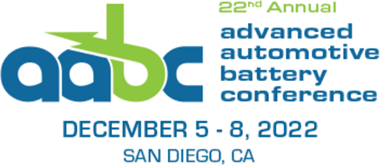Advanced Automotive Battery Conference (AABC 2022)

We attended AABC 2022 in San Diego, USA, a conference and exhibition that focuses on the Li-ion battery for EVs. Previous participations provided me with material that is now shared in Battery University. We also joined tutorials serving as refreshers. Here are a few highlights of interest.
The graphite anode in a Li-ion battery acts like a sponge absorbing lithium during charge and returns to the cathode on discharge. Not all lithium returns and some is misplaced between anode and cathode. This loss adds to internal resistance and capacity loss.
Liquid electrolyte provides conductivity that also builds the SEI (Solid Electrolyte Interface) to get electrical isolation between the positive and negative electrodes during formation. Ions move inside the battery while the electrons flow outside in wires through a load.
Several speakers predicted that the hyped lithium-metal batteries will not be commercially available until 2030 and later. The graphite anode in these batteries is replaced by lithium metal that passes lithium ions to the nickel-manganese cathode on discharge and back again on charge. Abundance of lithium promises high capacity, but lithium deposition cannot be well controlled. Voids form and dendrites develop that compromise safety. The cycle count is also low.
Moli Energy in Vancouver was one of the first companies to commercialize lithium-metal but went into receivership when in 1989 a fire in the hand of a Japanese cell phone user prompted a recall of tens of thousands of these batteries. In 1991, Sony stepped in to provide the first Li-ion with the graphite anode that is now the most commonly used lithium format. In 1998 Moli merged to become E-One Moli Energy to produce high quality Li-ion cells in Taiwan and Canada.
There is much talk about the solid-state Li-ion. This architecture is also delayed because of poor electrical conductivity when cold. Solid state means metallic or ceramic material serving as separator in which icons pass but electrons face an insulator. Glass and ceramics possess these characteristics but conductivity remains poor at low temperatures. Most solid-state batteries use polymers with some liquids
There is renewed interest in Lithium Iron Phosphate (LiFePO). This battery offers increased safety, uses readily available raw material and provides a long cycle life. The drawback is lower energy density compared to Li-ion. LiFePO batteries are mainly used in Chinese EVs.
Many large companies also entertain second life of EV batteries. Redeployment will likely be by modular level with a BMS controlling modules that do not need to be matched. Meanwhile, recyclers claim to retrieve valuable materials of Li-ion batteries using Hydro Processes without the need for subsidy.
Battery State-of-Health
Little emphasis was placed in testing battery state-of-health, but this will change. Provision to read battery SoH in EV and BESS will become mandatory, commanded by UN and EU to assure the full use of the battery. Regulations will be solidified over the years and displayed to battery users under Usable Battery Energy (UBE) at a required accuracy of 95%. We make our contribution by reading the electrochemical evidence of a battery with EIS from the inside out. The information is then complemented with big data taken by a BMS working from the outside in.
The Volvo presenter also invited the audience to explore SoH readout of batteries. Other users of large batteries will follow.
AABC 2022 is still a show to impress audiences from research labs to market. The much needed bridge from Workforce-to-Retirement remains missing. Learning how we can assist was the main reason for our attendance.
